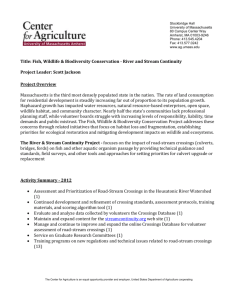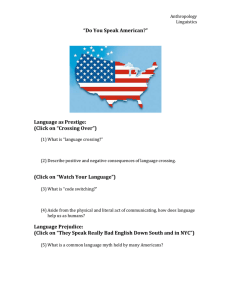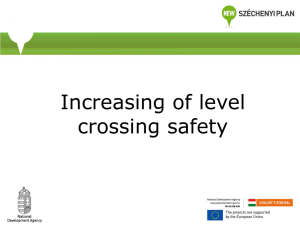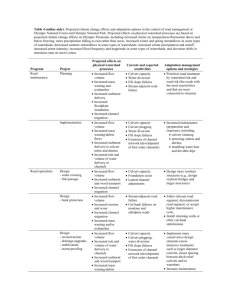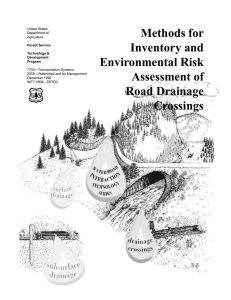Risk of Road-Stream Crossing Failure Name of indicator Questions potentially addressed
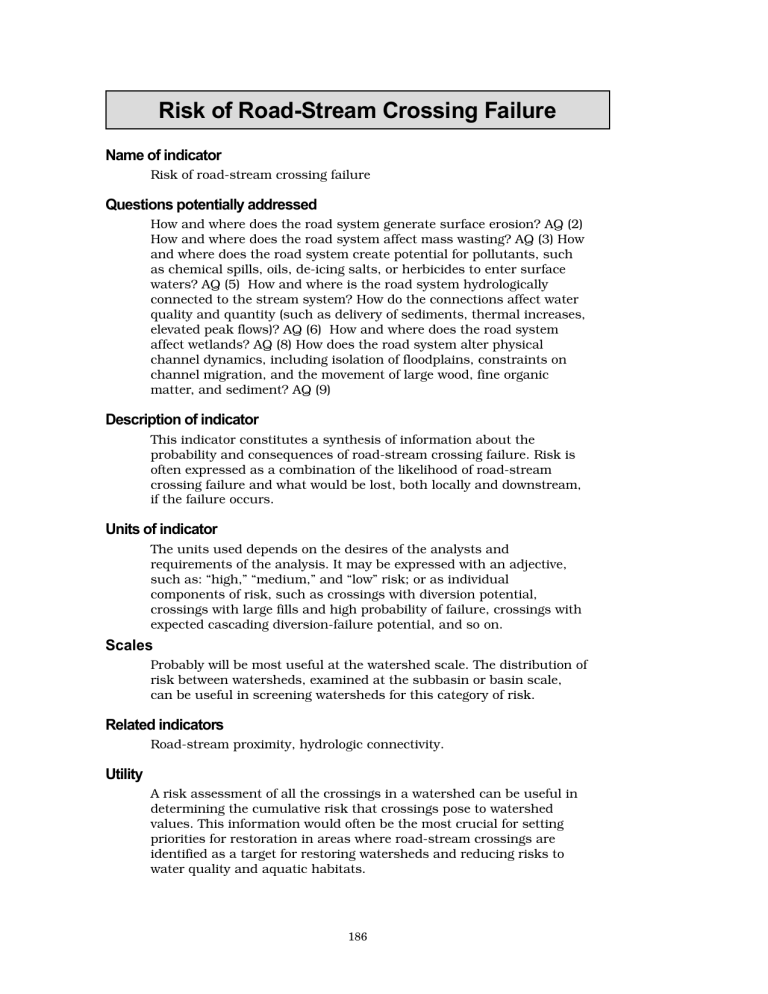
Risk of Road-Stream Crossing Failure
Name of indicator
Risk of road-stream crossing failure
Questions potentially addressed
How and where does the road system generate surface erosion? AQ (2)
How and where does the road system affect mass wasting? AQ (3) How and where does the road system create potential for pollutants, such as chemical spills, oils, de-icing salts, or herbicides to enter surface waters? AQ (5) How and where is the road system hydrologically connected to the stream system? How do the connections affect water quality and quantity (such as delivery of sediments, thermal increases, elevated peak flows)? AQ (6) How and where does the road system affect wetlands? AQ (8) How does the road system alter physical channel dynamics, including isolation of floodplains, constraints on channel migration, and the movement of large wood, fine organic matter, and sediment? AQ (9)
Description of indicator
This indicator constitutes a synthesis of information about the probability and consequences of road-stream crossing failure. Risk is often expressed as a combination of the likelihood of road-stream crossing failure and what would be lost, both locally and downstream, if the failure occurs.
Units of indicator
The units used depends on the desires of the analysts and requirements of the analysis. It may be expressed with an adjective, such as: “high,” “medium,” and “low” risk; or as individual components of risk, such as crossings with diversion potential, crossings with large fills and high probability of failure, crossings with expected cascading diversion-failure potential, and so on.
Scales
Probably will be most useful at the watershed scale. The distribution of risk between watersheds, examined at the subbasin or basin scale, can be useful in screening watersheds for this category of risk.
Related indicators
Road-stream proximity, hydrologic connectivity.
Utility
A risk assessment of all the crossings in a watershed can be useful in determining the cumulative risk that crossings pose to watershed values. This information would often be the most crucial for setting priorities for restoration in areas where road-stream crossings are identified as a target for restoring watersheds and reducing risks to water quality and aquatic habitats.
186
Acquisition
This indicator requires field inventory data of road-stream crossings. A complete inventory is desirable, but a sampling of crossings may be adequate if site-specific results are not needed. Important feature of crossing risk, such as fill volume, culvert capacity, and diversion potential cannot be predicted or estimated from underlying topography or other GIS layers.
Data needs
A minimum data set might include culvert diameter, fill volume or fill volume class, and stream diversion potential. A variety of other data would be needed for more sophisticated analyses.
Accuracy and precision
Accuracy of the probability of failure will likely be low to moderate, because of inaccuracies in models for estimating peak-flow, difficulties in discerning catchment area for small stream crossings, and the propensity of many crossings to fail because of sediment and woody debris loading, rather than simply exceeding hydraulic capacity.
Sediment and debris loading to a crossing cannot be effectively predicted. The configuration of the crossing inlet and the culvert gradient relative to the stream can provide a qualitative indicator of the probability of plugging, however.
Durability
Road-stream crossings are long-term investments and tend to be very durable. Changes occur when crossings are replaced routinely or after wash-out, and these changes are simple to track . .
Monitoring value
Tracking the change in road-stream crossing risk could be very useful to monitor the accomplishment and expected benefits from watershed restoration treatments that address crossing risk.
Limitations
Predictions of crossing failure are unlikely to correspond well with actual failures. Minimum consequences of failure can be reliably predicted, but actual consequences are often observed to be much greater, but they cannot be reliably predicted.
Typical availability
Requires field inventory of crossings, either a full census or a statistical sample. Road logs may indicate location of culverts and diameter, but seldom include fill volume or diversion potential.
Where applicable
Wherever roads cross streams, crossing structures of some kind are in place and present some risk to streams and water quality. The relative importance of crossing risk to watershed cumulative effects may differ greatly depending on the nature of the crossings and what other processes and land uses are or could affect the watershed.
187
Examples
A total of 223 road-stream crossings in the Bluff Creek watershed were inventoried and assessed for hazard and risk according to Flanagan et al. 1998. Risk in this context is defined as the probability of failure plus the expected fluvial erosion consequences. Each crossing is given a risk score based on the following:
• Culvert hydraulic capacity —Defined as the peak flow recurrence interval a culvert can pass at a specified headwater depth. For flows that submerge the inlet (HW/D = 1), 73 percent of the culverts will not pass a 100-year peak flow. Where drainage area was too small to delineate, hydraulic capacity was not calculated
(16 percent of the sites).
• Culvert sediment capacity —Defined as the relative slope of the culvert versus the natural channel – Sediment plugging hazard was considered high if the slope of the pipe divided by the natural channel slope was less than 0.3 (19 percent of the sites).
• Diversion potential —Half of the road-stream crossings in Bluff
Creek have the potential to divert stream flows down the road or ditch.
• Crossing fill volume —Fill volumes average 400 m 3 per site and 8 percent of the sites having fill volumes in excess of 1,000 m 3 .
Final hazard score is the sum of the above elements. Hazard scores range from one to nine. Crossing hazard was considered high if the score was greater than or equal to seven. Sites with scores less than four were considered low hazard. Scoring criteria are given below.
Capacity scoring elements are
• T —an expression of culvert hydraulic capacity (lowest T values are greatest hazard). Scores are:
• 3 - T < 10 years
• 2 - T = 10 - 100 years
• 1 - T > 100 years, and
• 0 - site does not have a definable drainage area (T cannot be calculated)
• s* —(slope of pipe / slope of channel) may be used to assess the ability of the culvert to transport sediment (lowest values are highest hazard).
• 2 - s* < 0.3
• 1 - s* = 0.3 - 0.6
• 0 - s* > 0.6
For consequence scores, crossings with stream diversion potential take priority over non-diversion-potential culverts because stream diversion typically results in much greater eroded volumes.
188
• Potential diversion distance (highest values are greatest hazard).
• 5 - distance > 300 m
• 3 - distance = 100-300 m
• 2 - distance = 50-100 m
• 1 - distance < 50 m
• 0 - no diversion potential
• Fill volume (largest volumes are greatest hazard).
• 4 - Volume > 1000 m 3
• 3 - Volume = 500 - 1000 m 3
• 2 - Volume = 100 - 500 m 3
• 1 - Volume < 100 m 3
Figure 2-43 shows the result of this rating, with crossing classified as either low, moderate, or high risk.
189
Example
Road - Stream Crossing Risk - Layer
Watershed - Scale
Bluff Creek Watershed
Orleans Ranger District
Six Rivers National Forest
8
"
8
8
"
8
" 8
"
"
"
8
"
" "
8
"
8
"
8
"
8
"
8
"
" 8
" 8
" "
" "
8
"
8 "
W
N
S
1:120,000
E
" "
" "
" 8
" "
8
"
" 8
8
"
8
"
"
"
8
8
" 8
"
"
8
8 "
8
"
"
8
"
8
8
"
"
"
" 8
1
Road-stream crossing risk
8 Low risk
"
"
Boundary
8 High risk
Crenulated streams
Road system
Decommissioned road
0 1 2 3 4 Miles

